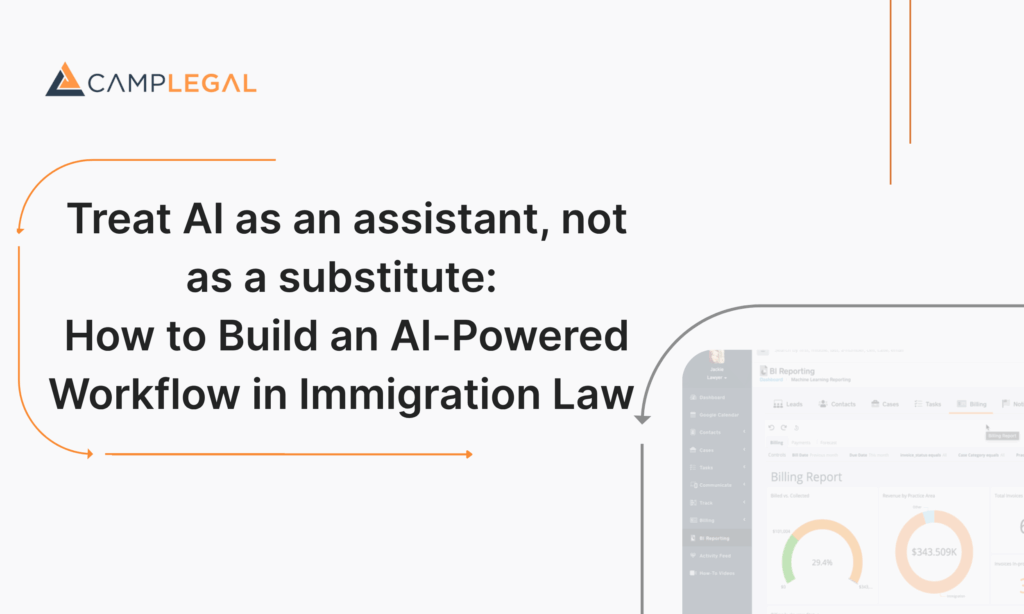Why Immigration Firms Are Turning to AI Workflows
Across the legal industry, immigration practices are increasingly experimenting with artificial intelligence to manage growing caseloads and repetitive document tasks. According to a 2025 American Bar Association (ABA) legal industry report, “respondents from firms with 51 or more lawyers, though representing a smaller subset of this survey’s participants, reported a significant 39% generative AI adoption rate. By contrast, firms with 50 or fewer lawyers had adoption rates at half that level, with approximately 20% indicating the implementation of legal-specific AI within their practices.”
For immigration attorneys, the appeal is clear. With higher RFE rates and longer USCIS processing times, efficiency tools can mean the difference between sustainable growth and staff burnout. But effective AI adoption requires structure, human oversight, and ethical boundaries. Without them, even well-intentioned firms risk serious professional consequences.
Step-by-Step: Setting Up an AI-Powered Workflow
1. Identify a Repetitive, High-Volume Task
Start small. Focus on areas that involve consistent inputs and clear outcomes, such as OCR-based document sorting, pre-populating USCIS forms, or automating client reminders through your immigration case management software.
2. Choose a Secure, Legal-Grade AI Platform
Evaluate potential tools based on security, data privacy, and regulatory compliance. Avoid systems that store data offshore or share client content with third parties to ensure that professional responsibility rules still apply when delegating work to technology.
3. Train and Calibrate with Real but Anonymized Data
AI tools improve through examples. Use redacted case files to teach the system to recognize missing evidence or inconsistent details in Form I-140 petitions. Never feed live client information into an unverified platform. We work with firms who use ChatGPT or Claude. You can purchase a business license where none of the data is used to train models.
4. Integrate with Existing Workflow Systems
The best results come when AI works alongside existing tools. Connect automation features with your billing, communication, and legal workflow software. Most modern solutions integrate through secure APIs that sync deadlines and client updates.
5. Monitor Outputs and Audit Regularly
Even advanced models make mistakes. Designate a reviewer to check every AI-generated draft before submission. Keep records of revisions to maintain accountability and demonstrate compliance if questions arise later.
When AI Goes Wrong: Lessons from a Misuse Case
In 2023, two New York attorneys made headlines after submitting a court filing generated by ChatGPT that contained fabricated case citations. The court sanctioned them for failing to verify their work, noting that they “abandoned their duties of candor and diligence.” (BBC News)
Although that case was not in the immigration field; the implications are universal. Any law firm that deploys AI without clear guidelines risks reputational and disciplinary harm. The problem was not the technology itself, but the absence of verification and policy. Immigration practices handle even more sensitive data, including clients’ personal histories and government-issued identifiers. Without documented rules for AI use, the consequences could be far more severe.
Establishing Firm-Wide AI Guidelines
To avoid similar pitfalls, every immigration firm should adopt written policies that specify how and when AI may be used. Strong internal governance should include:
- A list of approved tools and their data-handling procedures
- Requirements for human review of all AI outputs
- Regular training sessions on ethics, confidentiality, and technology literacy
- A record-keeping process documenting when AI was used in each matter
These measures create accountability and protect both clients and attorneys; firms should implement such frameworks before adopting advanced technology.
Takeaway: Responsible Innovation Builds Sustainable Efficiency
AI can transform immigration practice by eliminating routine tasks and improving accuracy, but only if implemented with oversight and transparency. Firms that create structured workflows, train their teams, and document every AI interaction will gain the full benefit of automation while avoiding ethical missteps. Treat AI as an assistant, not a substitute. With thoughtful governance, immigration attorneys can harness technology to serve clients more efficiently and with greater confidence.

